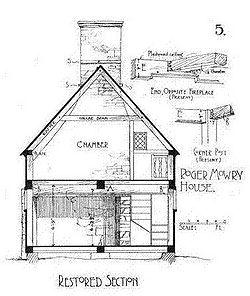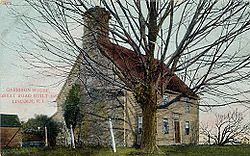
Stone ender
Encyclopedia


Rhode Island
The state of Rhode Island and Providence Plantations, more commonly referred to as Rhode Island , is a state in the New England region of the United States. It is the smallest U.S. state by area...
architecture that developed in the 17th century where one wall in a house is made up of a large stone chimney.
History
Rhode Island was first settled in 1636 by Roger WilliamsRoger Williams (theologian)
Roger Williams was an English Protestant theologian who was an early proponent of religious freedom and the separation of church and state. In 1636, he began the colony of Providence Plantation, which provided a refuge for religious minorities. Williams started the first Baptist church in America,...
and other colonists from England. Many of the colonists came from western England and brought the prevalent British architectural ideas with them to New England
New England
New England is a region in the northeastern corner of the United States consisting of the six states of Maine, New Hampshire, Vermont, Massachusetts, Rhode Island, and Connecticut...
but adapted these to the environment of Rhode Island. The colonists built “stone enders” which made use of the material that was in abundance in the area, timber and stone. Rhode Island also had an abundance of limestone
Limestone
Limestone is a sedimentary rock composed largely of the minerals calcite and aragonite, which are different crystal forms of calcium carbonate . Many limestones are composed from skeletal fragments of marine organisms such as coral or foraminifera....
(in contrast to the other New England states), and this allowed Rhode Islanders to make mortar
Mortar (masonry)
Mortar is a workable paste used to bind construction blocks together and fill the gaps between them. The blocks may be stone, brick, cinder blocks, etc. Mortar becomes hard when it sets, resulting in a rigid aggregate structure. Modern mortars are typically made from a mixture of sand, a binder...
to build massive end chimneys on their houses. Much of the lime was quarried at Limerock
Limerock
Lime Rock may refer to a place in the United States:* Lime Rock , a neighborhood in the village of Lakeville, Connecticut** Lime Rock Park, an auto racetrack* Lime Rock, Rhode Island, a village...
in Lincoln, Rhode Island
Lincoln, Rhode Island
Lincoln is a town in Providence County, Rhode Island, United States. The population was 21,105 at the 2010 census. Lincoln is located in northeastern Rhode Island, north of Providence....
. Only a few stone enders remain in the 21st century. Architectural restorationist, Norman Isham
Norman Isham
Norman Morrison Isham was a prominent architectural historian, restorationist, author, and professor at Brown University and RISD.-Biography:...
restored several original stone enders in the early 20th century,
(see: *Clement Weaver House and Clemence-Irons House
Clemence-Irons House
The Clemence-Irons House is an historic residential home in Johnston, Rhode Island, USA. It was built by Richard Clemence in 1691 and is a rare surviving example of a "stone ender," a once common building type first developed in the western part of England. The structure is on the U.S...
). Armand LaMontagne
Armand LaMontagne
Armand LaMontagne ranks as one of America's pre-eminent sculptors of celebrated personalities.-Education:LaMontagne is a graduate of Worcester Academy and Boston College. He is a self-taught artist who has honed his skills through practicing his profession.-Body of work:He is best recognized for...
, a Scituate sculptor, handbuilt a large 17th-century style stone-ender off of Route 6 in Scituate, Rhode Island
Scituate, Rhode Island
Scituate is a town in Providence County, Rhode Island, United States. The population was 10,329 at the 2010 census.-History:Scituate was first settled in 1710 by emigrants from Scituate, Massachusetts...
in the 1970s.
Description of a Stone-ender
Stone ender houses were usually timber-framed, one and one-half or two stories in height, with one room on each floor. One end of the house contained a massive stone chimney, which usually filled the entire end wall, thus giving the dwelling the name of “stone ender.” Robert O. Jones, in the Statewide Historical Preservation Report K-W-1, Warwick, Rhode Island, in 1981, noted that the windows were very small “casements filled with oiled paper” and that “the stairs to the upper chambers were steep, ladder-like structures usually squeezed in between the chimney and the front entrance.” He points out that a few houses may have had leaded glass windows, but that was very rare. For an example containing the leaded glass windows along with ladder-like, steep stairs, see: *Clement Weaver House, East Greenwich, Rhode IslandEast Greenwich, Rhode Island
East Greenwich is a town in and the county seat of Kent County, Rhode Island, United States. The population was 13,146 at the 2010 census. East Greenwich is the wealthiest municipality within the state of Rhode Island....
1679
List of early extant Rhode Island stone-enders (2010)
- Clemence-Irons HouseClemence-Irons HouseThe Clemence-Irons House is an historic residential home in Johnston, Rhode Island, USA. It was built by Richard Clemence in 1691 and is a rare surviving example of a "stone ender," a once common building type first developed in the western part of England. The structure is on the U.S...
, Johnston, Rhode IslandJohnston, Rhode IslandJohnston is a town in Providence County, Rhode Island, United States. The population was 28,769 at the 2010 census. Johnston is the site of the Clemence Irons House a stone-ender museum and the only landfill in Rhode Island...
1691 - Clement Weaver House, East Greenwich, Rhode IslandEast Greenwich, Rhode IslandEast Greenwich is a town in and the county seat of Kent County, Rhode Island, United States. The population was 13,146 at the 2010 census. East Greenwich is the wealthiest municipality within the state of Rhode Island....
1679 - Edward Searle HouseEdward Searle HouseThe Edward Searle House is an historic stone ender in Cranston, Rhode Island in the village of Oaklawn. The house is one of the oldest surviving buildings in the state....
, Cranston, Rhode IslandCranston, Rhode IslandCranston, once known as Pawtuxet, is a city in Providence County, Rhode Island, United States. With a population of 80,387 at the 2010 census, it is the third largest city in the state. The center of population of Rhode Island is located in Cranston...
1677 - Eleazer Arnold HouseEleazer Arnold HouseThe Eleazer Arnold House is a historic house built for Eleazor Arnold in about 1693, and located at 487 Great Road, Lincoln, Rhode Island in the Great Road Historic District...
, Lincoln, Rhode IslandLincoln, Rhode IslandLincoln is a town in Providence County, Rhode Island, United States. The population was 21,105 at the 2010 census. Lincoln is located in northeastern Rhode Island, north of Providence....
1693 - John Bliss HouseJohn Bliss HouseThe John Bliss House is an historic stone ender house on 2 Wilbur Avenue near Bliss Road in Newport, Rhode Island. The late seventeenth century Jacobean house is one of the oldest surviving buildings in Rhode Island....
, Newport, Rhode IslandNewport, Rhode IslandNewport is a city on Aquidneck Island in Newport County, Rhode Island, United States, about south of Providence. Known as a New England summer resort and for the famous Newport Mansions, it is the home of Salve Regina University and Naval Station Newport which houses the United States Naval War...
ca. 1680 - John Tripp House, ProvidenceProvidence, Rhode IslandProvidence is the capital and most populous city of Rhode Island and was one of the first cities established in the United States. Located in Providence County, it is the third largest city in the New England region...
/Newport, Rhode IslandNewport, Rhode IslandNewport is a city on Aquidneck Island in Newport County, Rhode Island, United States, about south of Providence. Known as a New England summer resort and for the famous Newport Mansions, it is the home of Salve Regina University and Naval Station Newport which houses the United States Naval War...
1720 - Smith-Appleby HouseSmith-Appleby HouseThe Smith-Appleby House Museum, built in 1696, is a historic house museum in Smithfield, Rhode Island, and the museum is home to the Smithfield Historical Society.-Description:...
, Smithfield, Rhode IslandSmithfield, Rhode IslandSmithfield is a town in Providence County, Rhode Island, United States. It includes the historic villages of Esmond, Georgiaville, Mountaindale, Hanton City, Stillwater and Greenville...
, 1696 (chimney later modified) - Thomas Fenner HouseThomas Fenner HouseThe Thomas Fenner House or the "Sam Joy Place" is an historic stone-ender house on 43 Stony Acre Drive in Cranston, Rhode Island. It is one of the oldest surviving houses in Rhode Island....
, Cranston, Rhode IslandCranston, Rhode IslandCranston, once known as Pawtuxet, is a city in Providence County, Rhode Island, United States. With a population of 80,387 at the 2010 census, it is the third largest city in the state. The center of population of Rhode Island is located in Cranston...
1677 - Valentine Whitman HouseValentine Whitman HouseThe Valentine Whitman House is an historic stone ender house on Great Road in Lincoln, Rhode Island. The house is one of the oldest surviving buildings in the state....
, Lincoln, Rhode IslandLincoln, Rhode IslandLincoln is a town in Providence County, Rhode Island, United States. The population was 21,105 at the 2010 census. Lincoln is located in northeastern Rhode Island, north of Providence....
1694

